Blue is an attention-grabbing color associated with the sky and symbolizes freedom, intuition, inspiration, and sensitivity.
That’s why seeing a bird that is blue can instantly brighten your day. The list of such birds, especially the small ones, is extensive.
Examples of small blue birds include the eastern bluebird, blue grosbeak, cerulean warbler, indigo bunting, blue bunting, collared kingfisher, swallow-tailed hummingbird, and many others.
The smallest blue bird in the world is the bee hummingbird which weighs less than 0.1 ounces and is around 2 inches long.
Some of these tiny blue-colored birds can be seen in the USA, like the eastern bluebird, indigo bunting, blue grosbeak, etc.
Table of Contents
Small Blue Birds
| Small Blue Birds | Wingspan | Length | Weight |
| Blue Jay | 13–17 in | 9–12 in | 2.5–3.5 oz |
| Purple Martin | 15.3–16.1 in | 7.5–7.9 in | 1.6–2.1 oz |
| California Scrub-jay | 15 in | 11-12 in | 2.8 oz |
| Blue Mockingbird | 13-15.5 in | 9.5-10.5 in | 1.7-2.1 oz |
| Blue Rock Thrush | 12-14 in | 8.3-9 in | 1.3-2.5 oz |
| Mountain Bluebird | 11-14.2 in | 6.1–7.1 in | 0.85–1.31 oz |
| Splendid Fairywren | 12-14 in | 5.1-6 in | 0.3-0.4 oz |
| Collared Kingfisher | 12.5-13.8 in | 9.1-9.8 in | 1.8-3.2 oz |
| Tree Swallow | 11.8-13.8 in | 4.7-5.5 in | 0.6-0.9 oz |
| Western Bluebird | 10-13 in | 5.9-7.1 in | 0.8-1.1 oz |
| Eastern Bluebird | 9.8–12.6 in | 6.3–8.3 in | 0.95–1.2 oz |
| Blue Grosbeak | 10-11 in | 5.5-7.5 in | 0.92-1.11 oz |
| White-breasted Nuthatch | 7.9–10.6 in | 5.1–5.5 in | 0.63–1.06 oz |
| Indigo Bunting | 7.1–9.1 in | 4.5–5.9 in | 0.40–0.75 oz |
| Blue Bunting | 8.5 in | 5.1-5.5 in | 0.35-0.85 in |
| Black-throated Blue Warbler | 7.5-7.9 in | 5.1 in | 0.30–0.44 oz |
| Cerulean Warbler | 7.9 in | 4.3 in | 0.28–0.35 oz |
| Pygmy Nuthatch | 7.8 in | 3.5–4.3 in | 0.3–0.4 oz |
| Swallow-tailed Hummingbird | 6.3-7 in | 6-6.7 in | 0.32 in |
| Bee Hummingbird | 1.3-1.5 in | 2.2-2.4 in | 0.069-0.092 oz |
Blue Jay
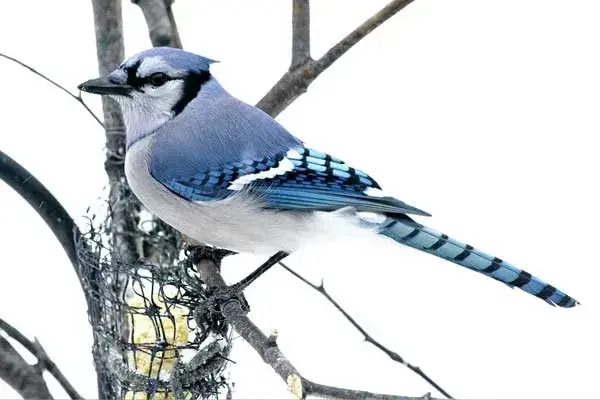
- Scientific Name: Cyanocitta cristata
- Lifespan: 7 years
- Wingspan: 13–17 in
- Length: 9–12 in
- Weight: 2.5–3.5 oz
Common around forests, woods, parks, and other urban areas with large oak trees, blue jays are rather small blue songbirds.
Males and females are alike and have lavender-blue color above and white color below. They also have black collars and white tails and throats. Their wings are blue and have white spots.
- Read More: 22+ examples of birds that have blue wings
On top of their head, there is a crest that can be used to indicate the birds’ mood – when agitated, the crest goes up and when frightened, the crest goes down.
According to Bergmann’s rule that says that animals living in warmer areas tend to be smaller than those living in colder ones, blue jays from warm Florida weigh less (2.6 oz) than those from colder Connecticut (3.26 oz on average).
Blue jays are very noisy birds that will often mimic hawk sounds when approaching a feeding site to drive away other birds. They make a large variety of sounds and may even learn to mimic human speech.
Blue jays’ song is a mixture of clicks, chucks, whirrs, whines, liquid notes, and elements of other calls. Their alarm call is a loud, almost gull-like scream.
Blue jays are not state birds in any US state; they are the mascot of Toronto Blue Jays, a Major League Baseball team.
These songbirds are highly intelligent and can even use tools.
Blue jays are boisterous birds that mate for life and work together to build a nest for their young. When the female sits on the eggs, the male will feed and take care of her.
Blue jays are omnivores that mostly feed on seeds, berries, nuts, and occasionally insects. They will also store food and eat it later.
Blue jays are common birds of Pennsylvania, Maryland, North Texas, Florida, and Central Texas.
Purple Martin
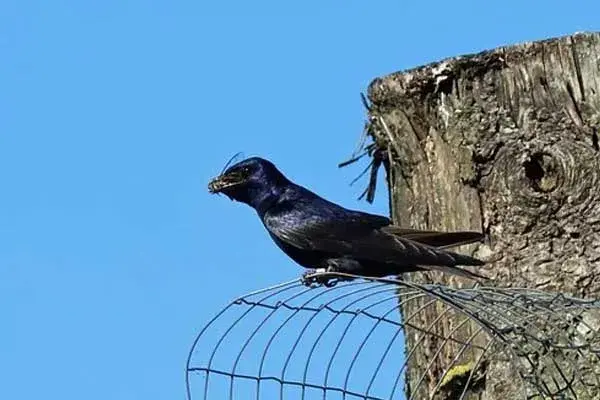
- Scientific Name: Progne subis
- Lifespan: 5-7 years
- Wingspan: 15.3–16.1 in
- Length: 7.5–7.9 in
- Weight: 1.6–2.1 oz
Slightly smaller than blue jays, purple martins are purple-blue swallows famous for their chattering song and aerial acrobatics.
These birds can be seen around fields, marshes, farms, and urban areas and are one of the first South American migrants to return to the USA.
After wintering in the rainforests of Brazil, purple martins will undertake a 7,000-mile-long journey to the eastern US and Canada. Males will be the first to arrive, a week or two before the females.
Purple martins are easy to identify by their notched tails, slightly hooked beaks, and long pointed wings. Males have completely dark purple-blue plumage while females are gray to mottled purple.
Purple martins are very vocal birds. Their most common songs are chirps, chortles, rattles, and croaks. When fighting over territory, purple martins will make a “hee-hee” and “zwrack” call when interacting with other species.
They are very social and colonial birds – their largest roosting colony ever discovered had over 700,000 birds!
Blue Mockingbird
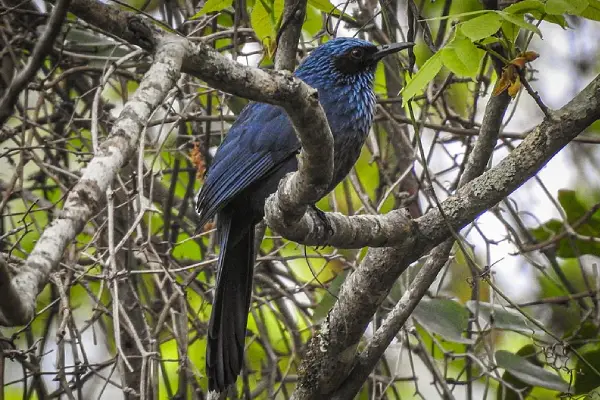
- Scientific Name: Melanotis caerulescens
- Lifespan: up to 8 years in the wild
- Wingspan: 13-15.5 in
- Length: 9.5-10.5 in
- Weight: 1.7-2.1 oz
Only distantly related to the USA’s northern mockingbirds, blue mockingbirds are small blue birds endemic to Mexico.
They measure from 9.5 to 10.5 inches in length, have a wingspan from 13 to 15.5 in, and weigh between 1.77 and 2.11 oz.
Blue mockingbirds are hard to be confused with other species in North America due to their blue plumage, black masks around the reddish-brown eyes, long tails, slightly curved beaks, and black legs and feet.
They are common around subtropical or tropical dry forests, subtropical or tropical moist montane forests, and heavily degraded former forests, at altitudes ranging from sea level to up to 10,000 feet in the mountains.
Blue mockingbirds will often hide out in thick vegetation, near the ground, and go higher when singing.
These birds are omnivores that feed on insects, spiders, fruits, and berries.
California Scrub-jay
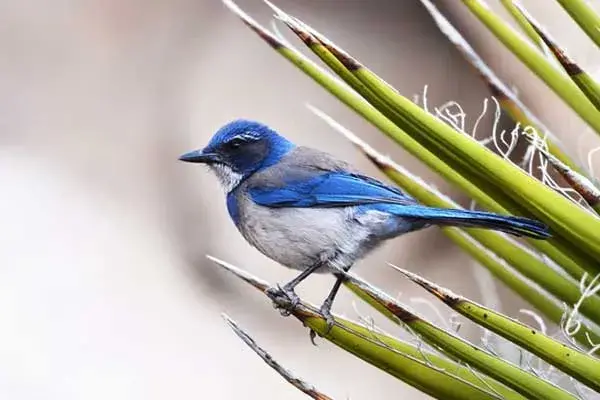
- Scientific Name: Aphelocoma californica
- Lifespan: 9 years
- Wingspan: 15 in
- Length: 11-12 in
- Weight: 2.8 oz
California scrub-jays are attractive jays found around parks, neighborhoods, and riverside woods near the Pacific Coast. They are native to the Western USA.
These birds have deep azure wings, heads, and tails, and white and soft gray-brown underparts. California scrub-jays also have white eyebrows, whitish throats, and blue necklaces.
- Read More: 20+ birds that have eyebrows on their heads
Their call is a harsh and scratchy “screech” and they can mimic the calls of various raptors.
California scrub-jays can be also seen sitting on the backs of different animals, cleaning them from ticks and other parasites.
These stunning blue and white birds are one of the most intelligent animals that have a brain-to-body mass ratio similar to that of chimpanzees.
They can plan for the future, they are the only non-primate that can do so, and can remember the locations of over 200 food stockpiles.
California scrub-jays will often steal acorns from acorn woodpeckers or other jays. When they go to hide their own, they will always check first that no other birds are watching – this might suggest that they can take into account the perspective of others.
These birds are omnivores that feed on insects, fruit, nuts, seeds, and some small animals such as lizards and nesting birds.
California scrub-jays are very aggressive and dangerous so smaller birds tend to avoid them.
Blue Rock Thrush

- Scientific Name: Monticola solitarius
- Lifespan: 5-10 years
- Wingspan: 12-14 in
- Length: 8.3-9 in
- Weight: 1.3-2.5 oz
Commonly found in Europe, Africa, and Asia, blue rock thrushes are starling-sized birds that can range from 8.3 to 9.1 inches in length and weigh as little as 1.3 oz.
Although named thrush, blue rock thrushes are actually chats.
These tiny blue birds can be seen on mountainsides, sea cliffs, quarries, ruins, and even around towns.
Male blue rock thrushes are easy to recognize by their blue-grey color and darker wings. They have medium-long tails. Females are much less striking and have dark brown upperparts and paler brown underparts.
They like to nest in rock cavities and walls and usually lay 3-5 eggs.
These birds are omnivores that feed on berries, seeds, snails, insects, locusts, worms, spiders, and even lizards, mice, and snakes.
The blue rock thrush is the national bird of Malta.
Splendid Fairywren
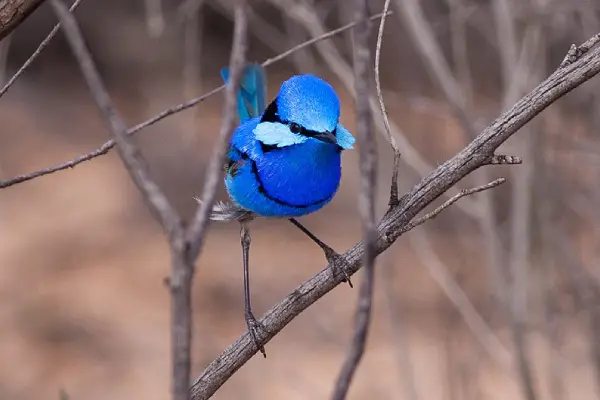
- Scientific Name: Malurus splendens
- Lifespan: 5-6 years
- Wingspan: 12-14 in
- Length: 5.1-6 in
- Weight: 0.3-0.4 oz
Splendid fairywrens are small birds with long blue tails that are often held cocked. They are common in Australia, living in typically dry and shrubby habitats.
Males and females look different.
During the breeding season, male splendid fairywrens are almost completely bright blue with deeper rich blue back wings, chests, and tails. They also have black beaks, eye bands, and chest bands. Non-breeding males are mostly brown with blue wings.
Females resemble non-breeding males and have chestnut beaks and eye patches.
These birds are very social and will form groups of two to eight individuals that will defend their territory year-round.
Splendid fairywrens are interesting for their reproductive behavior as these birds are socially monogamous and sexually promiscuous.
This means that a male and a female might form a pair, but each of them will mate with other birds and even help in raising the young from such engagements.
Splendid fairywrens are omnivores and feed on ants, grasshoppers, crickets, spiders, bugs, some seeds, flowers, and fruit.
Mountain Bluebird
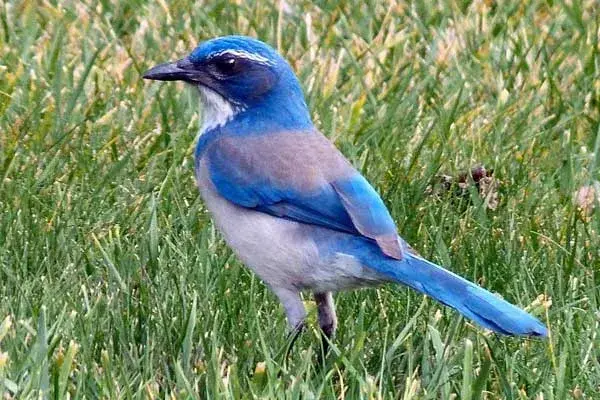
- Scientific Name: Sialia currucoides
- Lifespan: 6-9 years
- Wingspan: 11-14.2 in
- Length: 6.1–7.1 in
- Weight: 0.85–1.31 oz
Mountain bluebirds were once called Arctic or Ultramarine blue-birds, names that excellently describe their range and their vivid sky-blue plumage.
These small migratory thrushes are easy to recognize by their round heads and straight, thin beaks.
Males have bright sky-blue plumage, dark blue wings and tails, while the part under the tails is white.
Females have duller blue wings and tails and gray breasts, crowns, throats, and backs.
As the name suggests, mountain bluebirds can be found in mountainous habitats of western North America.
They are omnivores that mostly feed on spiders, grasshoppers, flies, other insects, and small fruits.
Wildlife experts estimate that there are around 4.6 million mountain bluebirds in existence today.
These small birds with blue feathers are secondary cavity nesters – mountain bluebirds will build their nests inside old woodpecker holes or naturally occurring holes in trees.
Males will look for nests but the females make the final decision as they are the ones that build the nest.
Mountain bluebirds are state birds of Idaho and Nevada.
Collared Kingfisher

- Scientific Name: Todiramphus chloris
- Lifespan: 11 years
- Wingspan: 12.5-13.8 in
- Length: 9.1-9.8 in
- Weight: 1.8-3.2 oz
Collared kingfishers are also known as white-collared kingfishers or mangrove kingfishers and can be found in Africa, Asia, and Australia. Although heavier than mountain bluebirds, they have a shorter wingspan, making them appear smaller.
These birds are easy to notice due to their conspicuous black kookaburra-like beaks, turquoise-blue wings and heads, white collars, and white chest feathers. Their feet are black.
Males tend to have a slightly more blue tint to their plumage, while females have a slightly more greenish one.
These birds take care of personal hygiene and will often take baths by jumping into the nearby rivers or lakes. After that, they can be seen drying and preening their feathers in bright sunlight.
Collared kingfishers are carnivores that feed on insects, crustaceans, small snakes, small birds, small fish, and even mice.
Tree Swallow
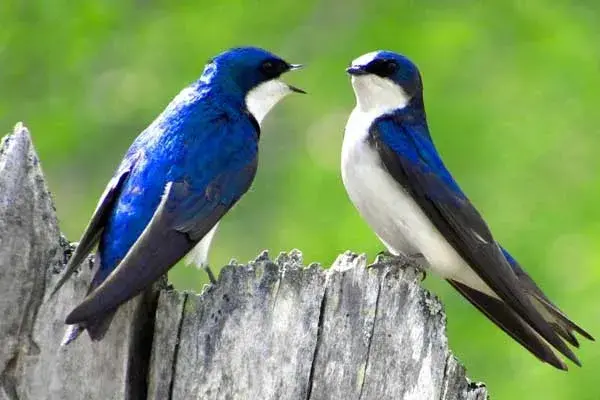
- Scientific Name: Tachycineta bicolor
- Lifespan: 3 years
- Wingspan: 11.8-13.8 in
- Length: 4.7-5.5 in
- Weight: 0.6-0.9 oz
These beautiful migratory songbirds breed in USA and Canada.
Tree swallows are easy to spot by their glossy blue-green upperparts, dark wings and tails, and white underparts. They have dark brown eyes, black beaks, and pale brown legs and feet.
Females have duller colors than males, mostly brown with some blue feathers.
Tree swallows are common in wet habitats like marshes, fields, farms, and woods. They are cavity nesters that might even use man-made nest boxes.
You will notice their long, pointed wings and short, squared, or slightly notched tails.
Tree swallows’ song is a cheerful series of liquid twitters that consist of three parts: the chirp, the whine, and the gurgle. They also have several calls: the chatter, short high-pitched submission call, ticking (or rasping) aggression call, the alarm call, and others.
Tree swallows are omnivores that feed on insects, mollusks, spiders, and occasionally on fruit, berries, and seeds.
Western Bluebird
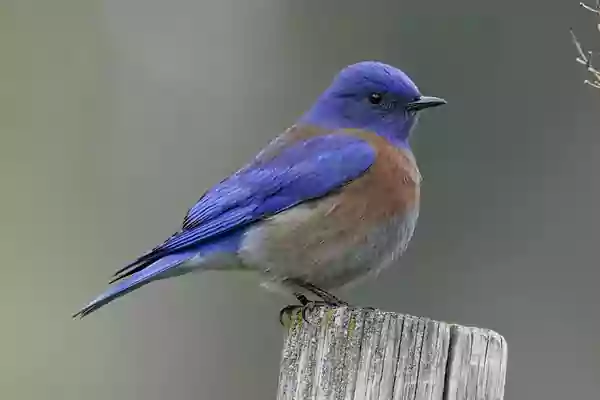
- Scientific Name: Sialia mexicana
- Lifespan: 1-2 years
- Wingspan: 10-13 in
- Length: 5.9-7.1 in
- Weight: 0.8-1.1 oz
With a wingspan of 10 to 13 in, western bluebirds look slightly smaller than tree swallows.
These small North American thrushes love to perch upright and can be identified by their deep blue-colored wings, orange breasts and sides, gray bellies, and thin straight bills.
Western bluebirds are common visitors of oak woodlands, mountain conifers, valley farms, and orchards.
To keep competition away and to locate females in the condensed forests, males will often make loud calls that sound like “cheer,” “chur-chur,” and “chup.”
Western bluebirds will often drop suddenly to the ground to catch insects; they are omnivores that also consume some berries.
They look similar to the other two species of bluebirds; the only difference is the throat color.
Western bluebirds have blue (male) or gray (female) throats, eastern bluebirds have orange throats, while mountain bluebirds have no orange color on themselves.
Western bluebirds mate for life. However, one 2003 study discovered that around 45% of western bluebird females had some young in their nests that were not sired by their current mates.
They are very common in California; read about other songbirds found there.
Eastern Bluebird

- Scientific Name: Sialia sialis
- Lifespan: 6-10 years
- Wingspan: 9.8–12.6 in
- Length: 6.3–8.3 in
- Weight: 0.95–1.2 oz
Eastern bluebirds are the smallest bluebird species in the world. They can weigh less than an ounce and have a wingspan of less than 10 inches.
These small North American migratory thrushes are easy to spot by their rounded heads, dark eyes, and alert posture.
Male eastern bluebirds have vivid royal blue heads and back plumage and warm red-brown and white breasts. Females are gray above with bluish wings and tails and subdued orange-brown bellies.
They prefer the open country with scattered trees, farms, and roadsides.
And similar to their cousins, the mountain bluebirds, the eastern bluebirds are cavity nesters that love nest boxes.
They are very social birds living in flocks with over 100 individuals, but also very territorial during the breeding season.
To attract a female, a male bluebird will sing over 1,000 songs per hour; it sings without opening its beak wide. They have a soft melodious warble song and a liquid and musical “turee” or “queedle” call.
These birds are omnivores that mostly feed on insects, including grasshoppers, crickets, beetles, caterpillars, and some fruit.
Eastern bluebirds are the official birds of Missouri and New York.
The bright blue colors of the males that can be easily spotted on wire or open perches, make these small blue birds very popular among birders.
Blue Grosbeak
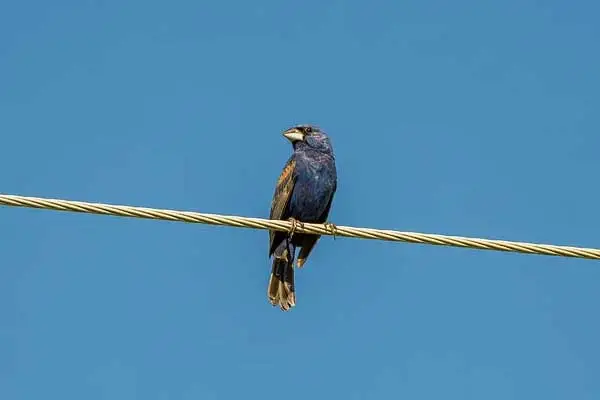
- Scientific Name: Passerina caerulea
- Lifespan: 6-7 years
- Wingspan: 10-11 in
- Length: 5.5-7.5 in
- Weight: 0.92-1.11 oz
Blue grosbeaks are small migratory birds that breed in northern Mexico and the southern US. You will recognize them by the large, triangular silver beak that almost covers their whole face.
One part of their scientific name, the “caerulea,” is a Latin word for “azure-blue”, “sky-blue” or “dark-blue,” which perfectly describes these birds.
Males have blue plumage and two brown bars on their wings while the females are mostly brown with some scattered blue feathers and two brown wing bars.
Similar to the smaller indigo buntings, blue grosbeaks prefer early successional habitats with vigorously growing grasses, forbs, shrubs, and trees.
These blue songbirds will occasionally use snakeskin when building their nests to scare off predators.
To attract the female, the male will sing, and when a female chooses him as her mate, he will sing louder than before.
Blue grosbeaks are omnivores that often forage on the ground, consuming insects and seeds of weeds, grasses, and other plants.
White-breasted Nuthatch
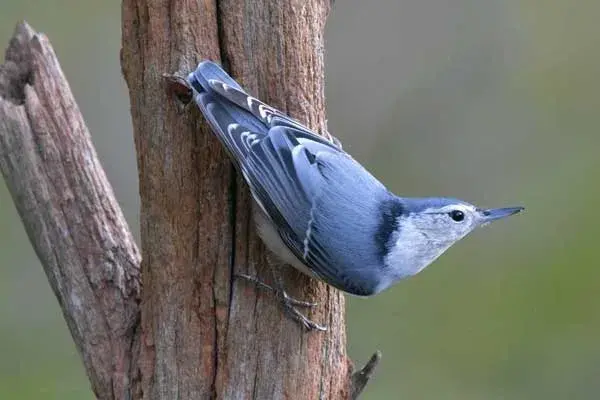
- Scientific Name: Sitta carolinensis
- Lifespan: 2 years
- Wingspan: 7.9–10.6 in
- Length: 5.1–5.5 in
- Weight: 0.63–1.06 oz
Despite being the largest nuthatch species in North America, white-breasted nuthatches still measure as little as 5.1 inches in length and often weigh less than an ounce.
They are common around forests and open areas and can be identified by their clean blue-gray and white plumage. The male and female look very much alike, the only difference is that the female has lighter color.
White-breasted nuthatches have small tails and almost no necks which make them look very stocky.
These quirky and loud birds got their name from the way they crack open seeds – they will jam their seeds and nuts into tree bark, and then whack it with their beaks to open the seeds.
To hear them, listen for a rapid series of low, nasal, whistled notes on one pitch “whi-whi” or “who-who.” Often, males will sing rapidly in the spring when they are trying to attract a mate.
White-breasted nuthatches are omnivores that feed on insects and seeds. They often visit backyard bird feeders so if you are lucky to attract them, their quirky personalities will provide you with endless entertainment.
There are 9 subspecies of white-breasted nuthatches with the smallest being the S. c. kinneari.
Indigo Bunting
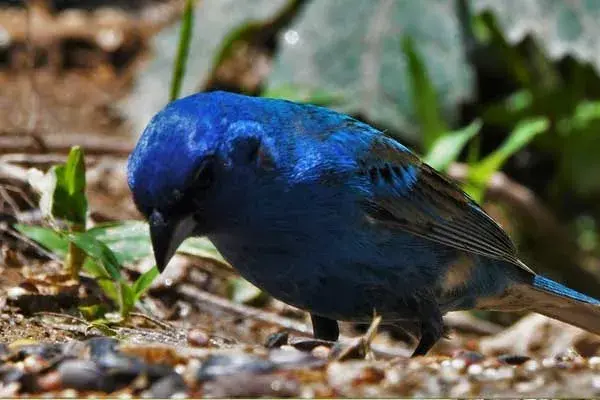
- Scientific Name: Passerina cyanea
- Lifespan: up to 10 years in the wild
- Wingspan: 7.1–9.1 in
- Length: 4.5–5.9 in
- Weight: 0.40–0.75 oz
Indigo buntings are small seed-eating birds with a length of just 4.5 to 5.9 inches and a weight of 0.4 to 0.75 oz.
They are common around woodlands, forests, parks, and gardens, and are frequent visitors to bird feeders.
Males have cerulean blue plumage during the breeding season. Their heads are indigo blue and the wings and tails are black with cerulean blue edges. They become brown during the non-breeding season; females are brown year-round.
Males love to sing and have a rapid, excited warble song with each note or phrase being given twice. When marking their territory or attracting females, males will emit a high-pitched song that lasts from two to four seconds and sounds like “sweet-sweet chew-chew.” Both sexes will also use a sharp “chip” alarm call.
Indigo buntings are territorial birds and omnivores that feed on insects, seeds, and berries.
These birds usually mate for life; occasionally, they may switch partners within a single breeding season.
Indigo buntings have two or more broods per year with three to four white eggs with a few brownish spots. Females are the ones to build the nest and incubate the eggs.
Blue Bunting

- Scientific Name: Cyanocompsa parellina
- Lifespan: 2-3 years
- Wingspan: 8.5 in
- Length: 5.1-5.5 in
- Weight: 0.35-0.85 in
Smaller than indigo buntings are blue buntings. These tiny blue birds are from 5.1 to 5.5 inches long and weigh as little as 0.35 oz.
Male blue buntings have various shades of blue on their plumage; the forehead and cheeks are sky blue, upperparts are blackish-blue, rumps are ultramarine, while the underparts are deep blue. Females are mostly dull brown.
They are common around dense thickets and woodland edges of Mexico and northern Central America and might occasionally visit southern Texas, mostly during winter.
Blue buntings are omnivores that feed on seeds and insects.
Black-throated Blue Warbler
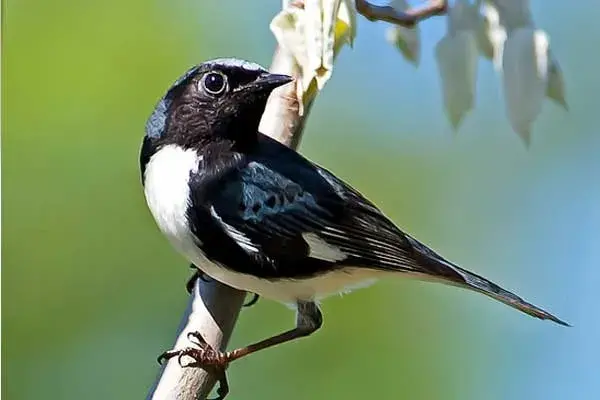
- Scientific Name: Setophaga caerulescens
- Lifespan: up to 10 years
- Wingspan: 7.5-7.9 in
- Length: 5.1 in
- Weight: 0.30–0.44 oz
Black-throated blue warblers are small songbirds that breed in Eastern North America. They can weigh as little as 0.3 oz and have a length of just 5.1 in.
They are sexually dimorphic species; males have the deep blue color of their upperparts, white underparts, and black faces and cheeks, while the females are olive-brown above and light yellow below.
Black-throated blue warblers do not change their appearance as the season changes and can be easily recognized in the fall and the spring.
When first discovered, since males and females look so different, people used to describe them as two separate species.
Black-throated blue warblers have a buzzed “zee-zee-zee” song with an upward inflection; their call is a flat “ctuk.”
They feed on insects, especially caterpillars, moths, crane flies, and also spiders. They might occasionally supplement their diet with some fruit.
Cerulean Warbler

- Scientific Name: Setophaga cerulea
- Lifespan: 6 years
- Wingspan: 7.9 in
- Length: 4.3 in
- Weight: 0.28–0.35 oz
Cerulean warblers are one of the smallest New World warblers, about 4.3 inches long, weighing around 0.3 ounces, and with a wingspan of around 7.9 inches.
These small blue-colored birds breed in eastern North American hardwood forests during summer and migrate south to winter in Andean mountain forests, from Colombia south to Bolivia.
They have one of the longest migrations of any small passerine bird, traveling almost 2,500 miles from breeding to nonbreeding grounds.
Cerulean warblers might be difficult to spot since they forage, sing, nest, and roost high in the canopy of mature forests.
Males are recognizable by their small, round bills, short tails, pale cerulean blue and white upperparts, a black necklace across the breasts, and black streaks on the backs and flanks. Females are blue-green above, yellow underneath, and have distinct pale supercilium (eyebrow) above the eyes.
The population of this migrant songbird is declining and is considered threatened.
Cerulean warblers are insectivores (carnivores) that primarily feed on insects such as flies, beetles, weevils, and caterpillars.
Click here to see what the smallest green birds look like or here to see the smallest white ones.
Pygmy Nuthatch

- Scientific Name: Sitta pygmaea
- Lifespan: up to 8 years
- Wingspan: 7.8 in
- Length: 3.5-4.3 in
- Weight: 0.3-0.4 oz
Pygmy nuthatches are the smallest nuthatches in the world. These tiny songbirds are around 4 inches long and weigh only 0.35 ounces on average.
They are scattered across the Western USA, usually around long-needled pine forests, especially with ponderosa pines.
Pygmy nuthatches will climb up and down these trees, feeding on insects and seeds.
They are easy to identify by their dark grayish-brown caps, blue-gray upperparts, and whitish underparts.
They are gregarious birds that can be seen in large noisy flocks high in the crowns of pine trees, often together with other songbirds. Pygmy nuthatches roost communally, occasionally with over 100 birds huddled in a single tree cavity.
Swallow-tailed Hummingbird
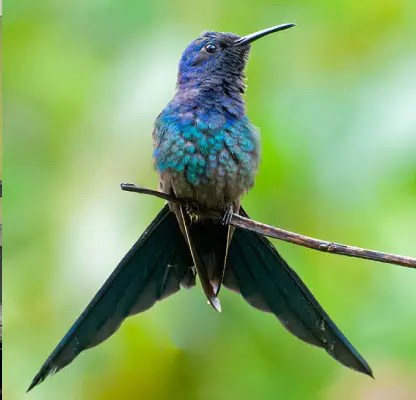
- Scientific Name: Eupetomena macroura
- Lifespan: n/a
- Wingspan: 6.3-7 in
- Length: 6-6.7 in
- Weight: 0.32 in
Swallow-tailed hummingbirds are small unmistakable birds commonly found in open and semiopen habitats, including forest edges, plantations, and urban areas.
They are from 6.6 to 7 inches long, half of which is the tail, and weigh only 0.3 oz.
Swallow-tailed hummingbirds have green-blue plumage, blue heads, upper chests, tails, and vents. They also have decurved medium-long black beaks and deeply forked dark blue tails.
Males and females look similar; females are about 25% smaller and slightly duller than males.
Depending on the hue of the plumage, there are 5 subspecies of these small blue birds.
Swallow-tailed hummingbirds got the name for their forked swallow-like tails.
They are native to South America and feed on flower nectar and some insects.
Swallow-tailed hummingbirds are very territorial and aggressive and will “dive-bomb” birds that are twice their size.
Read More: Examples of most common small birds in Michigan
Bee Hummingbird
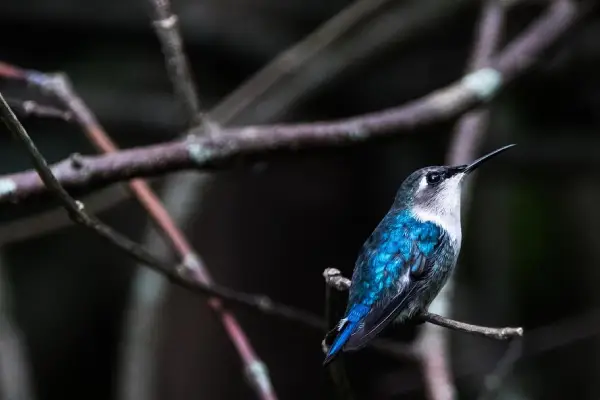
- Scientific Name: Mellisuga helenae
- Lifespan: up to 7 years in the wild
- Wingspan: 1.3-1.5 in
- Length: 2.2-2.4 in
- Weight: 0.069-0.092 oz
Bee hummingbirds are the world’s smallest blue birds. They are also known as zunzuncito or Helena hummingbirds.
Male bee hummingbirds are only 2.2 inches long, weigh only 0.069 ounces on average, and are smaller than females. Females weigh around 0.092 ounces and have a length of 2.4 inches.
Males are stunning and have turquoise upperparts and iridescent red heads while the females are turquoise above but dingy below.
These miniature birds are only found in Cuba; they lay their coffee-bean-sized eggs in nests the size of a quarter.
Bee hummingbirds got the name from the sound their wings make as it resembles that of a bumblebee.
While flying, they will beat their tiny wings around 80 times per second; during courtship rituals, that number increases up to 200 times per second!
Bee hummingbirds are omnivores that feed on flower nectar and insects, often consuming up to half their body weight in food per day.
Read More: 25+ examples of blue and orange birds
Summary
This concludes our list of small blue birds.
If you are interested in our list of small black birds, check this article. If you are interested in our list of big blue birds, check this one.
Examples of small blue-colored birds include several types of bluebirds, hummingbirds, nuthatches, jays, warblers, and many others.
Hopefully next time you see these birds, you will recognize any of them with ease!
And if you enjoyed our article, here’s another popular read on birds: List of 25+ huge black birds and list of 18 biggest birds in Texas.